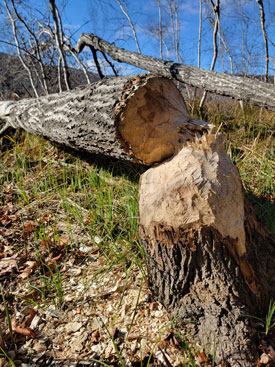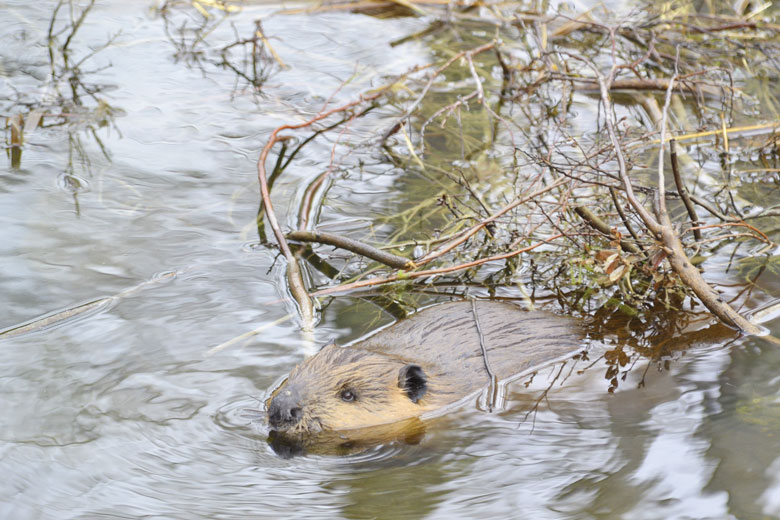Mount Desert Island is a watery place, thanks in part to the presence of beavers.
Acadia National Park staff and researchers have identified more than 250 beaver-influenced wetlands in the park. Beavers have limited space in Acadia’s steep topography to create “new” wetlands; instead, through their dam-building on streams and ponds, they expand, connect, and diversify existing aquatic ecosystems.
Beavers adjust water levels to support their plant-based foods, and to maintain access to their shelters of sticks and mud. In the process, they create habitat for all kinds of other plants and animals.
Beaver wetlands are also important spaces for humans.
Geologist Ellen Wohl calls the period between 1600 and 1900 when beavers were hunted and trapped out of the landscape the “Great Drying.”
When the canoe was a primary means of travel, beaver-created networks of surface water enabled people to move through the landscape and access important food, medicine, and materials. A few Wabanaki people had been hunting beaver and catching fish in 1604, when they encountered European navigator Samuel de Champlain along the shore of the place he later would name “Isle de Monts Desert.”
They traded some of their beaver furs, according to Champlain, in return for bread, tobaccco, and other items, which suggests that pelts were still common enough to be traded for “trifles.”
At that time, beaver fur was one of the most highly valued items of exchange between North America and Europe. The demand for fur contributed to the demise of beaver across the continent. Locally, beaver had been trapped to extinction by the 1800s, but animals from interior locations continued to supply a ready market.
In 1882, local newspapers reported that “large poke bonnets, with high tapering crowns” made of beaver fur in shades of bronze, green, red, brown, black, and white were in fashion and 10,267 beaver furs (of unidentified origin) had sold in London.

Without beavers to maintain them, many wetlands dried up and began to fill in with grasses, shrubs, and trees. Geologist Ellen Wohl calls the period between 1600 and 1900 when beavers were hunted and trapped out of the landscape the “Great Drying.” Trees spread into the desiccated soil of the meadows, and water drained more quickly into stream channels.
At the same time, a growing population of humans was filling in and altering wetlands and building roads across streams and valleys. Most people forgot how to live alongside beavers, although the memory of beavers persisted in Wabanaki oral history, and in place names on the MDI landscape: Beaver Meadow Pool (below Bubble Pond), Beaver Dam Pool (Bear Brook Pond), Beaver Brook Valley (Otter Creek-Cromwell Brook), and the Beaver Pool behind Sand Beach.
The early 20th century movement for wildlife conservation led some people to advocate for restoring beavers to the region. In 1921 the National Park Service, with assistance from Maine Fish and Game Commission, re-introduced beavers to Acadia beginning at Bubble Brook. A few years later, Vernon Bailey of the U.S. Biological Survey estimated a population of 25-30 across the park, in the Breakneck Ponds, Witch Hole Pond, New Mill Meadows, Eagle Lake, and on Little Hunters Brook.
“In all I have examined nine beaver houses that are occupied or have been recently occupied. There are many dams and some old houses that are not used. Many of the dams are built on the foundations of old dams, abandoned probably 150 to 200 years ago.”
As beaver families grew, new generations moved up into the flat valleys between the mountains, rewatering the land, reclaiming meadows from the cedar forests that had expanded in their absence. By 1932, beavers were living in Little Harbor Brook, and Marshall Brook on the west side of Mount Desert Island.
Their presence was newsworthy, as the Bar Harbor Times reported in 1934 that “A large beaver has made his appearance in the brook above the cemetery bridge, felling trees and evidently making preparations to spend the winter there.”
But it didn’t take long for beaver activity to affect human infrastructure, much of which was built during a time without beavers. Beaver dams flooded walking paths at Witch Hole Pond, where much of the trail had to be rerouted, and Lake Wood, where trail crews had to constantly remove dams from a bridge at the lake outlet, and water levels eventually covered much of the path that circled the lake.
The population rebounded so successfully that the National Park Service began trapping them, some to be relocated to the mainland. It was the beginning of the beginning of people re-learning how to live with beavers.
After the fire of 1947, the regrowth of abundant aspen and birch trees supported expansion of Acadia’s beaver population, which peaked around 1980 and then stabilized to around 100 individuals.
Today, park roads and other infrastructure continue to intersect with the lives of beavers and other wildlife. To a beaver, the flow emanating from a culvert is a “leak” in the water-retaining complex of dams and channels that must be repaired.
The National Park Service manages infrastructure, not beavers. Park staff will clear clogged culverts and install fencing devices (invented in Maine) known as “beaver deceivers” where streams flow under roads and trails. Otherwise, beavers are left alone to do their thing.
And their thing is incredibly important for park nature. Instead of considering beavers a problem, ecologists now recognize that beavers are key to healthy wetlands. Tiers and networks of beaver dams slow and spread water, fostering the growth of emergent aquatic plants, food they actually prefer to trees.
A complex pattern of water flow attracts a diversity of insects, amphibians, fish, and birds. Dead trees become pocked with nest cavities. Sediment settles out of the slowed water; downstream water is cleaner and clearer.
The upstream wetland becomes a sponge, buffering against high rainfall and flooding, and retaining water in areas that might otherwise go dry in extended periods between rain events.
“What looks to us like disorder is more properly described as complexity, a profusion of life-supporting habitats that benefit nearly everything that crawls, walks, flies, and swims in North America,” wrote Ben Goldfarb in Eager: The Surprising, Secret Life of Beavers and Why They Matter.
Today, few visitors are likely to encounter a beaver. But many visitors—as they experience a watery landscape vibrant with life—enjoy the influence of beavers in Acadia.
Catherine Schmitt is a communications specialist with Schoodic Institute at Acadia National Park.





